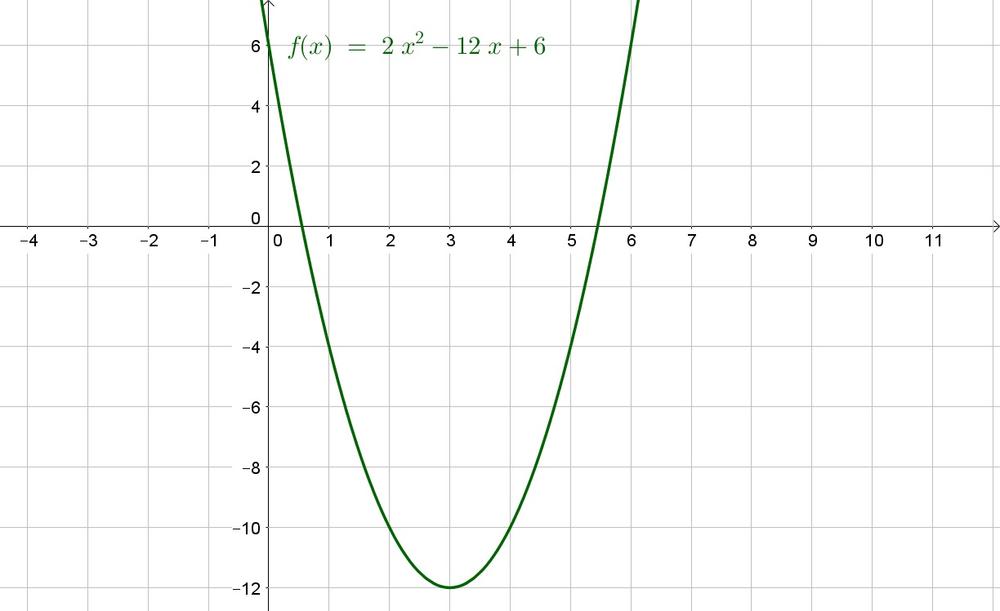All Solutions
Page 537: Closure Activity
a. $(2,9)$ is the vertex and it has to be a minimum because $a=1>0$.
b. Because if you subtract 9 from both sides of the equation, then you obtain that the square is equal to a negative number. Since only complex numbers have a negative square, the function can have no real roots.
c. Let $f(x)$ be 0:
$$
0=(x-2)^2+9
$$
Subtract 9 from both sides of the equation:
$$
-9=(x-2)^2
$$
Take the square root of both sides of the equation:
$$
pm 3i=pm sqrt{-9}=x-2
$$
Add 2 to both sides of the equation to obtain the roots of the function:
$$
2pm 3i=x
$$
b. No real roots
c. $x=2pm 3i$
$$
g(x)=f(x)+2=2x^2+2
$$
b. The graph is the graph of $f$ stretched vertically by factor 2:
$$
g(x)=2f(x)=2(2x^2)=4x^2
$$
c. The graph is the graph of $f$ translated left by 2 units:
$$
g(x)=f(x+2)=2(x+2)^2
$$
d. The graph is the graph of $f$ stretched horizontally by factor $dfrac{1}{2}$:
$$
g(x)=f(2x)=2(2x)^2=8x^2
$$
b. $g(x)=4x^2$
c. $g(x)=2(x+2)^2$
d. $g(x)=8x^2$
$$
y=(x^2-10x+25)+22-25
$$
Factorize the perfect square trinomial ($a^2pm 2ab+b^2=(apm b)^2$):
$$
y=(x-5)^2-3
$$
The vertex is then $(5,-3)$ and the $y$-intercept is $y=22$. Determine the $x$-intercepts using the quadratic formula:
$$
x=dfrac{10pm sqrt{(-10)^2-4(1)(22)}}{2(1)}=5pm sqrt{3}
$$
$$
y=(x^2+11x+30.25)+73-30.25
$$
Factorize the perfect square trinomial ($a^2pm 2ab+b^2=(apm b)^2$):
$$
y=(x+5.5)^2+42.75
$$
The vertex is then $(-5.5,42.75)$ and the $y$-intercepts is $y=73$. Determine the $x$-intercepts using the quadratic formula:
$$
x=dfrac{-11pm sqrt{11^2-4(1)(73)}}{2(1)}=dfrac{-11pm 3sqrt{19}i}{2}
$$
Thus this function has no $x$-intercepts.
Vertex $(5,-3)$
$x$-intercepts: $(5pm sqrt{3},0$
$y$-intercept: $(0,22)$
b.
Vertex $(-5.5,42.75)$
$x$-intercepts: None
$y$-intercepts: $(0,73)$
b. Subtract the two equations:
$$
0=(x+2)^2+2x+4=x^2+6x+8
$$
Factorize:
$$
0=(x+4)(x+2)
$$
Zero product property:
$$
x+4=0text{ or }x+2=0
$$
Solve each equation to $x$:
$$
x=-4text{ or }x=-2
$$
Determine $y$:
$$
y=-2x-4=-2(-4)-4=8-4=4
$$
$$
y=-2x-4=-2(-2)-4=4-4=0
$$
Thus the solutions are $(-4,4)$ and $(-2,0)$.
b. $(-4,4)$ and $(-2,0)$
$$
x-2geq 2
$$
Add 2 to both sides of the inequality;
$$
xgeq 4
$$

$$
3x+7=pm 12
$$
Subtract 7 from both isdes of the equation:
$$
3x=-7pm 12
$$
Divide both sides of the equation by 3:
$$
x=-dfrac{7}{3}pm 4=dfrac{5}{3}text{ or }-dfrac{19}{3}
$$

$$
(x-4)(x+1)<0
$$
Since the function opens upwards:
$$
-1<x<4
$$

b. $x=frac{5}{3}$ or $x=-frac{19}{3}$
c. $-1<x<4$
b. The axis of symmetry is
$$
x=-dfrac{b}{2a}=-dfrac{-12}{2(2)}=3
$$
Determine the image at $x=3$:
$$
y=2(3)^2-12(3)+6=18-36+6=-12
$$
Thus the vertex is $(3,-12)$.
c.

b. $(3,-12)$
c. Graph
$$
P(4)=dfrac{2}{3}cdot dfrac{1}{4}+dfrac{1}{3}cdot dfrac{2}{5}=dfrac{1}{6}+dfrac{2}{15}=dfrac{3}{10}=0.3=30%
$$
$$
P(6)=dfrac{2}{3}cdot dfrac{1}{4}+dfrac{1}{3}cdot dfrac{1}{4}=dfrac{2}{12}+dfrac{1}{12}=dfrac{1}{4}=0.25=25%
$$
Then we obtain:
$$
P(4or6)=P(4)+P(6)=30%+25%=55%
$$
$$
P(0)=dfrac{2}{3}cdot dfrac{1}{4}=dfrac{1}{6}approx 0.167=16.7%
$$
c. The probability of an event happening is 100% decreased by the probability of the event not happening:
$$
P(not 0)=100%-P(0)=100%-16.7%=83.3%
$$
d. Use the multiplication rule:
$$
P(S2given2)=dfrac{P(S2and2)}{P(2)}=dfrac{dfrac{2}{3}cdot dfrac{1}{4}}{dfrac{2}{3}cdot dfrac{1}{4}+dfrac{1}{3}cdot dfrac{7}{20}}=dfrac{1/6}{17/60}=dfrac{10}{17}approx 0.588=58.8%
$$
e. The multiplication rule states that the probability of an event A happening given that event B has happened is the probability of both events happening (at the same time) divided by the probability of event B happening.
b. $frac{1}{6}approx 0.167=16.7%$
c. $frac{5}{6}approx 0.833=83.3%$
d. $frac{10}{17}approx0.588=58.8%$
e. Answers wil lvary
$$
dfrac{NE}{AK}=dfrac{96′}{24′}=frac{4}{1}color{#4257b2}=4:1
$$
b. The perimeter ratio is equal to the side length ratio and thus the perimeter of $triangle ENC$ is four times as large as the perimeter of $triangle KAR$.
c. Multiply the corresponding side length with the ratio:
$$
EC=7’cdot 4=28′
$$
b. $4:1$
c. 28′
$$
(28-2)180text{textdegree}=4,680text{textdegree}
$$
$$
n=dfrac{360text{textdegree}}{42text{textdegree}}approx 8.5
$$
Since the result is not an integer, this regular polygon does not exist.
$$
text{color{#4257b2}Note: If the pentagon is regular, then:\
The sum of all interior angles is $(n-2)180text{textdegree}$ with $n$ the number of sides:
$$(5-2)180text{textdegree}=540text{textdegree}$$
The measure of the interior angle is then the sum of all interior angles divided by the number of angles:
$$dfrac{540text{textdegree}}{5}=108text{textdegree}$$}
$$
$$
(10-2)180text{textdegree}=1,440text{textdegree}
$$
The measure of the interior angle is then the sum of all interior angles divided by the number of angles:
$$
dfrac{1,440text{textdegree}}{10}=144text{textdegree}
$$
b. Not possible
c. Not possible
d. 144$text{textdegree}$
a.
$$
$1000cdot dfrac{1}{4} +$0cdot dfrac{3}{4}=$250
$$
b.
$$
$1000cdot dfrac{1}{360} +$0cdot dfrac{359}{360}approx $2.78
$$
c. Since the expected value is one fifth of the winning price:
$$
P(winning$1000)=dfrac{1}{5}=0.2=20%
$$
Thus for the angle we then obtain:
$$
mangle ACB = dfrac{360text{textdegree}}{5}=72text{textdegree}
$$
b. $$2.78$
c. $frac{1}{5}$, 72$text{textdegree}$
overline{AB}cong overline{DE}(text{Given})
$$
$$
overline{AC}cong overline{CD}(text{Radius circle})
$$
$$
overline{BC}cong overline{CE}(text{Radius circle})
$$
$$
Downarrow SSS
$$
$$
triangle ABC cong triangle DEC
$$
$$
Downarrow
$$
$$
angle ACB cong angle DCE
$$

